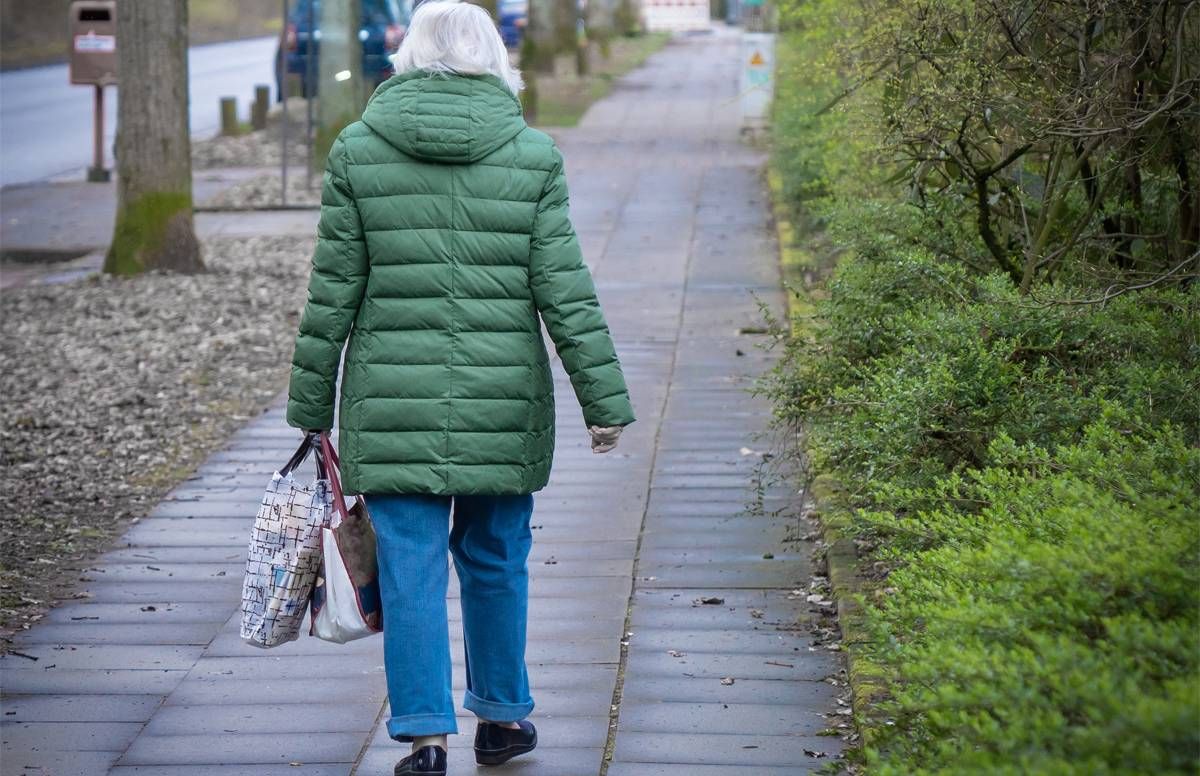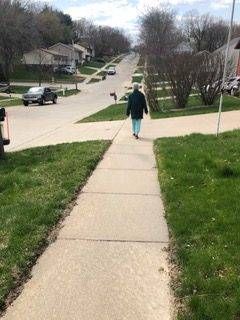Taking a Familiar Walk: Dementia Amid COVID-19
A daughter experiences the neighborhood from her mom's perspective
My 95-year-old mother has reached the limits of her patience with the daughter in her basement. As one of her nine children currently helping out, I take no personal offense. Even for people without dementia, COVID-19 can complicate a well-planned life.

“I’m going away,” she declares one mid-spring day. “Everyone in this place has something to do but me!” My dad and I have just emerged from his office from where we ordered groceries online. She doesn’t understand this new system, and she believes I have overstepped my role.
Mom finds her wool coat and struggles with its zipper. Dad leans in to see how he can help. They turn to me, and I quickly zip the uncooperative coat.
As a power play among younger people who might wish to exert control, running away can be particularly problematic for people with dementia like my mom. Yet here we are, Dad and I both acting as accomplices as if Mom were a temperamental kindergartner bound to return before dinner.
She reaches for her hat and scarf. “Do you want the red one?” Dad asks helpfully. She ignores him and grabs the gray hat with matching scarf. Strands of frizzy silver curls slip out from under her cap, and she slides red Keds onto her feet. Wearing the same sweat outfit she has donned over the past few days, she suddenly looks more youthful.
“You can’t come with me!” she barks at me. Dad pleads for her to reconsider.
"I'm going away," she declares one mid-spring day. "Everyone in this place has something to do but me!"
“I’m just going for the mail,” I tell her. Stay non-confrontational, I whisper to Dad.
With Dad on one side and me on the other, she manages a step from the front door, then another step off the stoop. Her eyes narrow, and she begins a steady pace along the front sidewalk.

She pauses at the driveway. “Which way did Sam go?” she says aloud to no one. Sam was my late brother with Down syndrome who regularly walked to a bus stop for his job.
Mom looks left, starts in that direction, then stops.
“There’s neighbors there,” she speaks again to herself, allowing me privileged insight as to how her mind is working.
Following Closely Behind
She glances in the opposite direction and sees a hill. “That’s too high,” she says, and I marvel how one part of her is speaking for another part to hear. She resumes her original direction, but now crosses the street.
“Hi Fran!” Pauline, the neighbor she sought to avoid, waves after watching for a bit. Mom makes no acknowledgement, her feet pattering on the pavement. Ten feet behind her, I serve as her shadow in stealth. I smile at Pauline, shaking my head and pointing to my ears to suggest Mom’s hearing inadequacies.
I follow Mom down the hill and around the bend. Tracking her requires few skills attributed to private eyes; I could have practically stepped on the back of her shoe without being spotted. While systematically on guard, she is less capable of easily turning around.
The neighbor teen on his driveway peers momentarily at this odd-looking lady who is overdressed in temperatures approaching 80 degrees. He smirks, resuming the whump, whump, whump of his basketball before pivoting in an easy layup.
From the other side, the mail truck approaches. The mailman looks at Mom as if he’s unsure how he might be of help. While swift for a person her age, Mom walks gingerly, almost like a child with autism, her big toe angling up, and it is perhaps this rigidity that alerts the viewer that something is slightly off. Mom slows at the tree, grabbing a branch. She seems to wish to wait for the mail truck to pass before resuming her plan.
It is at that moment that she turns around and finds me standing at her back. “Hi Mom! What are you doing over here?” I feign happy surprise that our paths should cross at just this moment. The ruse seems to work. “I am heading over there,” Mom points with no rancor in her voice.
I fall in line with her pace and we turn down another street. “The road is closed that way. Maybe we need to go a different way,” I suggest, pointing to the diamond-shaped construction sign. She continues past the sign. We proceed as two toddlers locked in parallel play, aware but not working at all together.
A Walk She Needed
“Where are you going?” I ask after a bit.
“Sam walked this way to catch the bus. It took him downtown,” she explains.
“And then what?” I ask.
“Who knows?” she replies without pausing. She tolerates my presence, perhaps welcoming another mind to support her if things turn rough. I marvel at the workings of her plan, as if following breadcrumbs left by Sam in a different time when buses operated because that’s what buses are supposed to do.
“Why do you want to go downtown?” I ask.
“I want to get to the railroad. Where my father worked,” she explains. She has talked recently about her need to get to her father at the train station, a commuter system that no longer exists in our town. Her father died a half-century ago.
She says she needs to rest and maneuvers herself atop a a tree stump cut at waist level. She watches the birds and feels the breeze, then eventually gets up to walk again.
“You’ve come an awful long way,” I suggest.
"I thank you for walking with me," she says so softly I lean to hear her words. She still doesn't look at me, but her voice conveys warmth that surprises me.
No answer.
“I wonder if we might turn around,” I probe gently.
“I’d like to get to the top of the hill,” she starts and then seems to change her mind. She turns around, like Forrest Gump who abruptly ends after running across the country.
“I thank you for walking with me,” she says so softly I lean to hear her words. She still doesn’t look at me, but her voice conveys warmth that surprises me. There is something she needed in this, I realize.
Life Is More Than Just Staying Alive
We continue silently, less fast-paced than on the outward jaunt. She rests at times, but then starts moving again. She reaches the side door to the garage.
“Do you need a hand?” Dad’s face suddenly appears at the doorway, surely watchful for her return.

“No, I can do it myself.” Her voice is resolute but without confrontation. Still, she takes his hand, then ambles up two steps.
When she turns, her eyes suggest a glimpse of a larger world. Her autonomy expanded just a little, other parts loosened from more rigid bounds. In this moment, her opinions still matter and her inner compass is shaken to new life. She looks straight at me.
“Thank you, Laurie,”she says, as if for that moment she can see me as something more than the invader in her land.
Life is more than just staying alive, her presence seems to say. Like unsteady feet on pavement, uncertainties will always arise. “Let life happen to you,” the poet Rilke wrote more than a century ago. “Life is in the right, always.”
The dual punch of dementia and COVID-19 is not easy, not even one little bit. But if we pay attention, maybe there’s still something we can learn.

